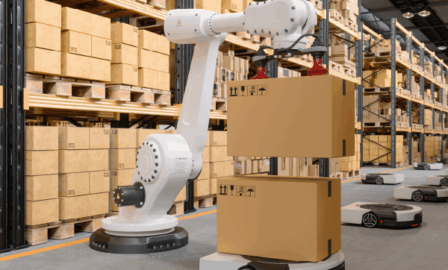How AI Can Improve Inventory Optimization in the Supply Chain
The key mandate for the inventory management team at a consumer products company is to have just the right amount of inventory, in just the right location, at just the right time. Too much inventory increases inventory carrying costs and creates a risk of expiration, while too little inventory might mean an out-of-stock situation, lost revenue, and lower customer service levels.
Getting inventory balanced, especially when there are likely many distribution centers and many different production facilities to consider, can feel like a mix of art and science. Fortunately, with Artificial Intelligence (AI) and Machine Learning, the “science” or calculated side of this endeavor can get a huge boost of cognitive power. In this piece, we explore how AI can improve inventory optimization in the supply chain.
AI’s Role in Improving Inventory Optimization
AI can help to efficiently allocate inventory across the distribution network by recommending production signals and distribution strategies. As an example, based on past customer service levels and fulfillment information, an AI model could assess how to distribute inventory across the network to optimize service to the customer, making recommendations on the inventory’s distribution across warehouses, including timing and quantity.
Additionally, this assessment could be even more nuanced, if that’s helpful to your organization. For example, is the goal to optimize customer satisfaction across the entire range of your customers or for specific customers during a specific timeframe, such as during a big, shared promotion? AI can leverage past information to create an optimized recommendation for both situations, including this more nuanced and specific use case. This would be extremely challenging to achieve without AI augmentation.
Using AI in Inventory Optimization: A Phased Approach
Using AI to enhance your organization’s inventory optimization strategy does not need to happen overnight. We recommend that organizations consider this evolution of capabilities: Crawl, Walk, Run.
Crawl
A solid data foundation, including data management and data pipelines, is necessary to leverage the advantages that AI can provide. This foundation is so important that even if you’re not ready to adopt advanced analytics or an AI-augmented supply chain today, it’s still a great time to build this foundation. It adds value immediately in terms of time saved, more accurate information, strengthened key performance indicators (KPIs), timely access to data, regulatory compliance, and more. For a consumer products company to truly excel in the market, timely and accurate data is needed.
Once you have that solid data foundation, you could then start with applying AI to a very specific use case. For instance, to the example above, a model could be applied to assess past distribution decisions and customer ordering patterns to recommend to inventory planners how they should allocate their current inventory across the distribution network, signaling specific quantities and timing for how much, where, and when the inventory should move.
As you consider even this initial situation, it’s important to also keep in mind and partner with your technical teams to understand your organization’s long-term data and analytics strategy. Applied specifically here, do you want to create this model yourself (or with the help of an outside provider) or buy software that manages the model? There are pros and cons to each of these options, and adopting the approach for this phase that best fits into your organization’s longer-term data analytics strategy will help you immensely down the road.
Walk
Once you have this data analytics foundation and allocation algorithm applied, why not optimize more across the inventory management landscape? Consider how AI can impact forecasting and production or purchasing of inventory, for example.
- Forecasting: AI is exceptionally strong at pattern recognition, finding correlations that may not be apparent to human supply chain analysts. This makes AI an excellent tool for demand planning. It can provide several benefits, such as: finding correlations between promotions and sales increases to measure promotional effectiveness; identifying the impact of social media mentions on consumer sales; or even predicting the impact of weather on product sales. All of these can be used to improve demand sensing and indicate the need for inventory movements.
- Production or purchasing of inventory: The AI model can make recommendations on the optimum timing, quantity, and sourcing partner for obtaining inventory and pulling it into your distribution network. By also incorporating this, you could then have an AI-augmented inventory plan that includes both pulling inventory into your network and optimizing its allocation across the network.
Run
A more fully integrated data landscape of your supply chain would enable AI models to make recommendations across the end-to-end supply chain, augmenting the decision-making power of your team members and resulting in more optimal ordering patterns for your suppliers, improved inventory levels, and higher customer service levels.
Real-time end-to-end supply chain visibility is possible with a data infrastructure that connects you with suppliers, distributors, customers, and logistics providers. AI can analyze large volumes of often disparate data and provide recommendations for inventory movements to optimize customer service and profit. Multi-echelon inventory optimization (MEIO) can be performed on-demand in real time to meet current needs, rather than waiting on a periodic batch run to determine inventory targets. And further, AI can monitor critical production and warehouse equipment in real time, indicating the need for maintenance, formulating alternative schedules when necessary, and avoiding costly downtime.
Looking Ahead
As a supply chain leader, you should assess your current inventory management data landscape, evaluating how analytic augmentation could help you optimize your inventory. In turn, this will also optimize the effectiveness of your teams, who could then increase their ability to deliver strong results to the organization’s inventory goals and KPIs by delivering improved results against internal metrics and even stronger customer satisfaction levels. In addition, this will also better enable your teams to build their skills to perform successfully in this continually evolving data analytics landscape.
Reach out to us today to learn more about our data and analytics services, including how to implement AI and other advanced analytics into your inventory optimization program.
Subscribe to Clarkston's Insights



